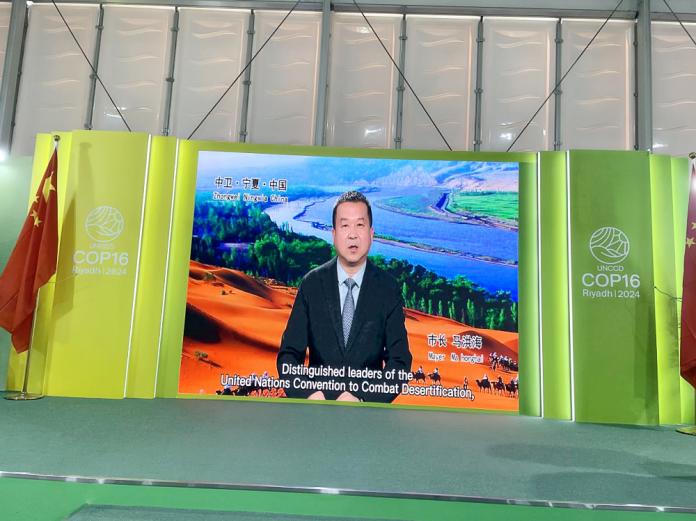[International Energy Network On-site Report] On December 10, 2024, a side event titled “Planning and Ecological Design of Solar PV Power Stations in Desert Areas” was held at the China Pavilion of the 16th Conference of the Parties (COP16) to the United Nations Convention to Combat Desertification in Riyadh. This side event was hosted by The Research Center for Energy Transition and Social Development,School of Social Sciences,Tsinghua University, and co-hosted by China Renewable Energy Engineering Institute and China National Sand Control and Desert Industry Society and Institute for Carbon Neutrality, Tsinghua University and Ningxia Longyuan New Energy Co., Ltd and International Energy Network.
During the meeting, Ma Honghai, Mayor of Zhongwei in Ningxia province, delivered a speech to share the achievement in desertification control.

A total of 100,000 hectares of desert have been reclaimed, showing the “Zhongwei Model” to the world
Ma Honghai said, Zhongwei is located at the southeastern edge of the Tengger Desert, one of China’s four major deserts. Known as the “Pearl of the Desert,” our city was once among the most severely affected areas by wind and sand hazards in China. Over the past 70 years, generations of Zhongwei’s people have dedicated themselves tirelessly to desert control efforts. Leveraging innovative techniques such as the “straw checkerboard method” and water-conducting planting tools, Zhongwei has successfully rehabilitated 100,000 hectares of desert, achieving a remarkable dual reduction in desertification and land degradation. These efforts have culminated in the creation of the “Shapotou Model,” a pioneering desertification control approach characterized by a five-layer integrated system. Zhongwei is also the birthplace of China’s iconic straw checkerboard technique, globally recognized as a symbol of effective desert management.
In recent years, Zhongwei has thoroughly implemented President Xi Jinping’s vision for ecological civilization, striving to integrate ecological protection with industrial development. We have launched a comprehensive campaign to combat desertification in the “bend of the Yellow River” region. Through the rapid growth of desert tourism, desert agriculture, and desert-based photovoltaic industries, Zhongwei has forged a path of development that harmonizes ecological, social, and economic benefits. Our city’s effective practices and successful experiences in desertification control have drawn thousands of experts and scholars from around the globe to study and learn from our achievements, offering a “Chinese Solution” and showcasing the “Zhongwei Model” to the world.
Constructing a 6GW photovoltaic desert control project, which will lead to the treatment of 12,000 hectares of desert
President Xi Jinping has emphasized the importance of “accelerating the planning and construction of large-scale wind and photovoltaic energy bases in desert, Gobi, and arid areas” and “strengthening comprehensive desertification control.” Responding to these directives, Zhongwei has pioneered three integrated models: “photovoltaics plus grasslands,” “photovoltaics plus shrublands,” and “photovoltaics plus desert rehabilitation.” By leveraging the “Ningxia-Hunan Direct Current” transmission project, Zhongwei has collaborated with leading enterprises such as Longyuan Power and Guodian Power to establish the “Shagohuang” new energy industry base. This initiative integrates photovoltaic power generation with ecological restoration and agricultural development, creating a sustainable system of “power generation above, ecological restoration below, and cultivation in between.”
6 GW photovoltaic desert rehabilitation project in the Tengger Desert has already seen 2 GW connected to the grid, effectively rehabilitating 4,000 hectares of desert. Once fully completed, the project will restore 12,000 hectares of desert land, achieving a transformative improvement to the environment.
Ma Honghai said, Zhongwei will leverage the Tengger Desert 6 GW photovoltaic project to establish an innovation and demonstration base for photovoltaic-ecological synergy. This base will focus on scientific research, technological validation, and public education. We are honored to have experts from leading institutions, including Tsinghua University, the China Institute of Water Resources and Hydropower Research, the China Society for Desertification Control, and the Chinese Academy of Sciences, serve as advisors to this base.
Ma Honghai firmly believe that,Zhongwei’s photovoltaic-ecological innovation and demonstration base will become a global center for photovoltaic technology and desertification control. Together, we can share and advance innovative technologies in desert management, contributing to the building of a shared community of life on Earth and a cleaner, more beautiful world.






